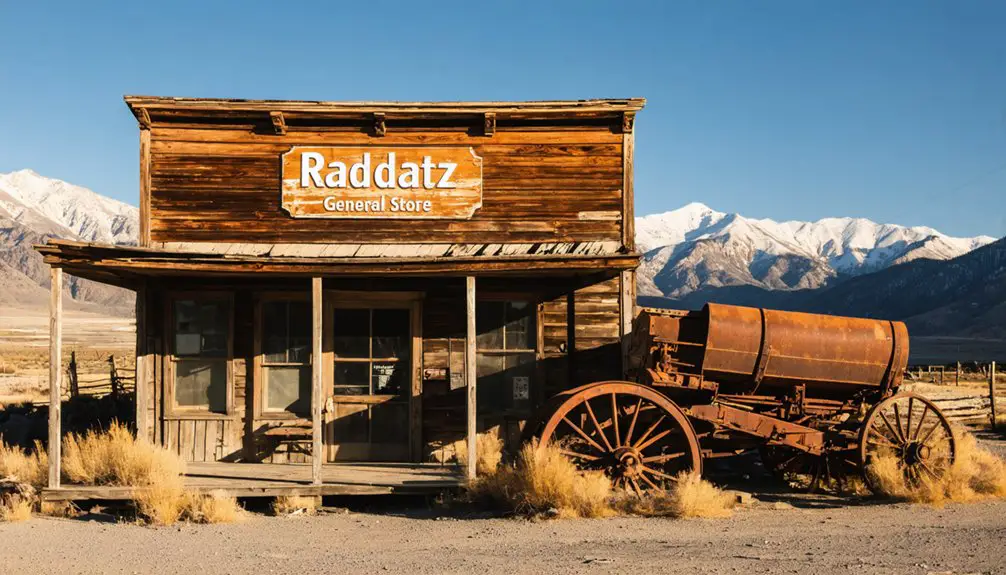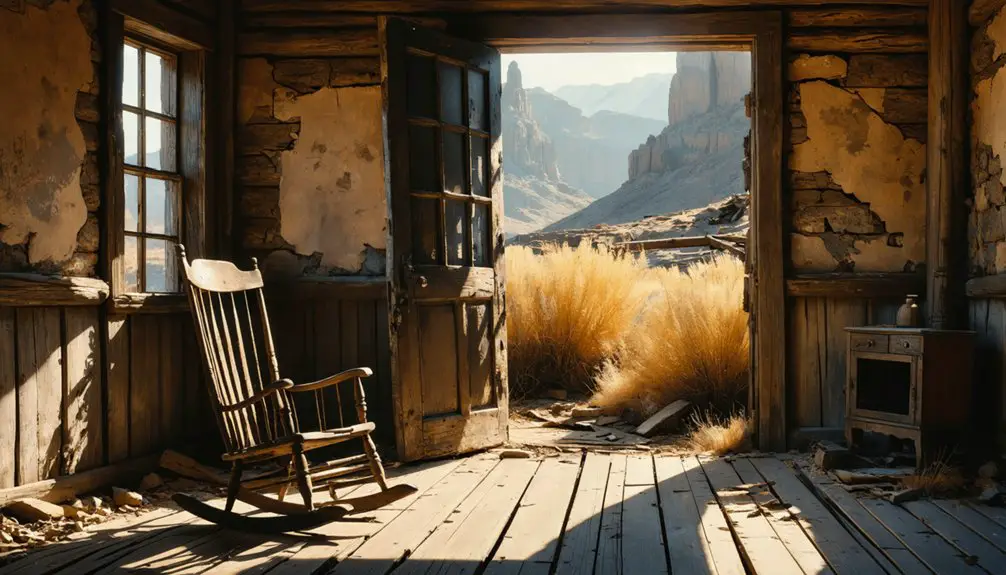You’ll discover Dividend, Utah’s ruins in the eastern Tintic Range, where a prosperous mining town once thrived at 5,000 feet elevation. Founded in 1918 by the Tintic Standard Mining Company, the town boasted modern amenities, sports facilities, and produced over $80 million in ore value during its peak years. After the mines closed in 1949, residents abandoned their homes, leaving only concrete foundations and weathered walls to tell the story of this remarkable company town.
Key Takeaways
- Dividend was a prosperous Utah mining town established in 1916 that became a ghost town after mining operations ceased in 1949.
- Located in Utah’s Tintic District, the town produced over $80 million in ore value during its peak mining years.
- The community featured 75 modern homes, indoor plumbing, recreational facilities, and supported approximately 350 residents during peak operations.
- Most buildings were dismantled in the 1950s to reduce property taxes after the mine’s closure and post office shutdown.
- Today, only concrete foundations and stone walls remain at the site, making it a destination for ghost town enthusiasts.
The Birth of a Mining Company Town
When Captain Emil J. Raddatz arrived in Utah’s Tintic District in 1907, he’d soon transform the eastern range into one of the region’s most prosperous mining ventures.
After securing claims and incorporating the Tintic Standard Mining Company, his mining techniques wouldn’t strike paydirt for nearly a decade. But persistence paid off in 1916 when they finally hit the motherlode.
For nearly ten years, Raddatz’s mining yielded nothing – until 1916 brought the spectacular strike they’d been seeking all along.
The company management quickly established a town, initially named “Standard,” to support their gold and silver extraction operations. By 1921, the Tintic Standard Reduction Mill was fully operational and processing ore.
By 1918, they’d renamed it Dividend and built an impressive array of amenities uncommon for mining settlements. The town experienced a significant boom in the 1920s with rapid home construction.
You’ll find it wasn’t your typical rough-and-tumble company town – they installed indoor plumbing and constructed comfortable frame homes, a twelve-room lodging house, and even recreational facilities including baseball fields and a golf course.
Location and Geographic Features
You’ll find Dividend nestled in the slopes of the eastern Tintic Range at elevations ranging from 4,700 to 6,400 feet above sea level.
The ghost town‘s mountain setting, characterized by rugged terrain and steep trails, sits within southwest Utah County’s historic mining district. Like how quarterly dividends are standard in the United States, this Utah mining town followed regular production schedules during its operational years. Similar to how corporations must maintain financial health to sustain dividend payments, the town’s prosperity depended on consistent mineral production.
From this remote location, you’re about 3-4 miles over the mountains from Eureka and roughly 14 miles southeast of Spanish Fork.
Mountain Slopes and Elevation
Nestled within the rugged Tintic Mountains of southwest Utah County, Dividend occupies a dramatic mountainous setting characterized by steep slopes and challenging terrain.
You’ll find the ghost town perched at coordinates 39°57′17″N and 112°03′41″W, where elevation challenges shaped every aspect of daily life and mining operations.
The town’s layout adapted to the natural contours, with buildings and mining structures carefully positioned for slope stability.
Rocky outcrops and cliffs dictated the placement of mines, while steep gradients influenced water systems and transportation routes.
Before modern roads, you’d have faced a difficult 3-4 mile trek over mountain trails to reach nearby Eureka.
From higher ridges, you can spot Utah Lake in the distance, emphasizing Dividend’s commanding position within these resource-rich mountains.
Similar to how the USS Kimberley had to navigate challenging waters, miners tackled the steep mountain terrain daily.
The vertical shaft mining strategy implemented in 1909 proved essential for reaching the deep ore deposits that would later transform the town’s fortunes.
Eastern Tintic Range Setting
The East Tintic Mountains dominate central Utah’s landscape as a striking north-south fault block range spanning 229 square miles across Juab, Utah, and Tooele counties.
You’ll find this majestic range about 50 miles south of Salt Lake City, where it rises boldly from the surrounding Tintic Valley at 5,600 feet and Goshen Valley at 4,500 feet.
The range’s Tintic geology reveals a complex story of ancient seabeds turned mountain peaks through massive tectonic forces.
You’re looking at thousands of feet of folded and faulted rock layers, now crowned by volcanic flows and cut by deep gulches on the western slopes.
When you’re exploring the eastern valleys, you’ll notice how the mountains form a natural boundary between the Great Basin and the Wasatch Front, with peaks soaring to over 8,000 feet, including Boulter Peak at its highest point.
The area’s remarkable geology includes over 3000 meters of sediments deposited during the lower to middle Paleozoic marine period.
Southwest Utah County Position
Within southwest Utah County, Dividend stakes its claim at coordinates 39°57′17″N and 112°03′41″W, positioned roughly 14 miles southeast of Spanish Fork.
You’ll find this ghost town nestled in the mountainous terrain near the historic Tintic Mining District, just a few miles over the peaks from Eureka.
The geographic significance of Dividend’s location stems from its strategic placement among the rugged hills and valleys characteristic of Utah’s mining regions.
In its regional context, you’re looking at high desert country where sagebrush and juniper dot the arid landscape.
The town’s position offered access to valuable ore deposits while maintaining connections to established mining routes.
Though water was scarce, the settlement’s carefully planned infrastructure included hillside water tanks and modern amenities unusual for mining communities of that era.
Mining Operations and Economic Success
Mining operations in Dividend began in 1907 when Emil J. Raddatz established the Tintic Standard Mining Company, marking the start of an ambitious venture in industrial innovation. Located two miles east of Eureka, the site proved ideal for mineral extraction.
The early years were marked by irregular wage payments, with workers often receiving company stock instead of cash. After years of persistence, the mine struck a profitable ore body, transforming Dividend from a small settlement into a thriving company town.
You’ll find the economic cycles of mining perfectly illustrated in Dividend’s story, where the operation generated over $80 million in ore value during its peak years.
- The mine produced an impressive 2.3 million tons of ore, paying out $19 million in dividends to shareholders
- The Harold Mill, built in 1919, showcased cutting-edge technology with its unique Augustin process
- Production peaked at 200 tons daily before declining ore quality led to the mine’s closure in the late 1940s
Daily Life in Early Dividend

As a Dividend resident in the early 1900s, you’d spend your days amid a bustling mining town where life centered around the mine’s daily operations and the supporting businesses that kept the community running.
You’d find your family living in one of the 75 single-family homes arranged in neat streets, where children attended the local schoolhouse while adults worked in the mines or managed essential services like the grocery store and hotel.
After work, you could join your neighbors at the pool hall or amusement hall, where the town’s 350 residents gathered to unwind and strengthen the social bonds that helped them weather the challenges of frontier mining life.
Work and Social Activities
Life in early Dividend revolved around the demanding rhythms of mine work, though the town’s remarkable social amenities helped create a vibrant community despite its isolation.
You’d find miners heading to work near the Number 2 shaft each day, but after hours, the town came alive with community gatherings and recreational activities that would rival larger settlements.
- Free movie nights every Wednesday brought families together at the amusement hall
- A baseball field and unusual golf course offered outdoor entertainment options
- The pool hall, barber shop, and dance venues served as social hubs for the town’s 200 residents
Despite poor road conditions making travel difficult, especially in winter, Dividend’s residents built a close-knit community through these shared social spaces and activities, transforming a remote mining camp into a proper town with surprising amenities.
Family and Home Life
Families in early Dividend enjoyed remarkable amenities that set their mining town apart from typical frontier settlements. You’d find indoor plumbing in the 75 single-family homes, a luxury few Utah towns could boast in the early 1900s.
The close-knit community of about 350 residents created strong family traditions despite the challenges of mining life.
Your daily needs were met at the Dividend Trading Company store, which expanded in 1924 to better serve local families. Community gatherings centered around the town’s recreational spaces, including baseball fields and a golf course.
While parents worked the mines, children attended the local schoolhouse, and older students traveled to nearby Goshen or Payson for secondary education. The town’s layout kept families close to the mine operations, fostering a tight-knit mining community.
Modern Amenities and Infrastructure
Three pioneering amenities set Dividend apart from other early Utah mining towns: indoor plumbing, recreational facilities, and extensive medical care.
You would’ve found modern conveniences that were rare for the era, making life more comfortable for the 200+ residents who called this company town home during the 1920s.
- A network of community amenities included the Dividend Trading Company store, which provided affordable goods to mining families.
- Sports enthusiasts enjoyed a baseball field, golf course, and tennis courts, offering diverse recreational options.
- Resident doctors lived on-site, ensuring workers and their families received consistent medical attention.
This forward-thinking infrastructure turned what could have been just another mining camp into a thriving community, though today only concrete foundations and mining structures remain to tell the tale.
The Legacy of Emil J. Raddatz

When Emil J. Raddatz founded the Tintic Standard Mining Company in 1907, he’d transform an unproductive stretch of Utah’s landscape into a thriving mining enterprise. His innovative approach to securing claims and raising capital through share distribution laid the groundwork for one of the region’s most significant mining operations.
Raddatz’s innovations extended beyond mining techniques. You can trace his vision in the development of Dividend, a purpose-built company town that provided workers with modern amenities, and in the construction of the Harold Mill – the only U.S. facility to employ the unique Augustin ore processing method.
His expertise in mining law and operations, gained from years working in Colorado and Mexico, proved essential in establishing this industrial foothold. Even after the mines’ closure, Raddatz’s legacy endures as a symbol of early 20th-century mining ingenuity.
Peak Years and Population Growth
You’ll find Dividend’s most prosperous period unfolded throughout the 1920s, as mining profits attracted workers and their families to fill the rapidly expanding housing developments.
The town’s population swelled from 200 residents in 1918 to nearly 500 by 1930, including a vibrant Mexican community that added cultural diversity to this bustling mining town.
During these peak years, Dividend flourished with essential amenities like a post office, school, boarding houses, and even its own newspaper, The Standard, which served the community from 1924 to 1925.
Mining Drives Population Growth
After the Tintic Standard Mining Company’s remarkable 1916 ore strike, Dividend experienced a dramatic population surge that transformed the area from empty terrain into a bustling company town.
You’ll find that mining impact directly fueled population trends, as the town grew from just 200 residents in 1918 to nearly 500 by 1930. The discovery marked a turning point after nearly a decade of unprofitable operations.
- The mine became one of the Tintic District’s most productive operations, helping the region rank 20th nationally in gold production.
- A significant Mexican-American workforce joined the community, diversifying the town’s demographic makeup.
- Mining wealth supported rapid development of housing, boarding houses, and schools for the growing population.
While smaller than nearby Eureka’s peak of 4,000 residents, Dividend’s growth was remarkably swift and entirely dependent on mining success.
Housing Development Timeline
Since its humble beginnings in 1907, Dividend’s housing development tracked closely with the town’s mining fortunes and population growth.
You’ll find that the town’s initial housing architecture consisted of just fifteen frame houses, but by 1918, when the population reached 200, you’d have seen a more developed community layout with essential structures like the post office and school.
The 1920s brought significant expansion as mining profits soared past one million dollars.
The housing architecture evolved to include modern amenities – Dividend became one of Utah’s first towns with indoor plumbing.
You’d have discovered impressive community features like a baseball diamond, golf course, and tennis courts.
The town’s layout centered around miners’ frame dwellings, creating a close-knit community that thrived until the 1930s, when mining decline began forcing residents to leave.
Community Life During Prosperity
During Dividend’s peak prosperity in the 1920s and early 1930s, the town blossomed into a vibrant mining community of nearly 500 residents.
You’d find a diverse population, including a notable Mexican workforce that brought their cultural traditions to this company-controlled settlement. The Tintic Standard Mining Company shaped daily life, providing essential services and employment that kept the town thriving.
- The community gathered at the twelve-room lodging house and boarding facility, where workers shared meals and stories.
- Children attended the local school, which served as a hub for education and social events.
- The Standard newspaper, though short-lived (1924-1925), kept residents connected with local happenings.
Life centered around the mine’s schedule, with community gatherings reflecting the tight-knit nature of this isolated but determined mining town.
The Tintic Mining District Connection
The Tintic Mining District emerged as one of Utah’s most prosperous mining regions following the discovery of the Sunbeam Mine by Mormon prospectors in 1869. This rich mining heritage transformed Utah’s economic landscape, with the district becoming second only to Bingham Canyon in total mineral production.
You’ll find evidence of its incredible wealth in the staggering numbers: by 1959, the district had yielded 2.6 million ounces of gold and 250 million ounces of silver.
The district’s economic transformations directly shaped Dividend’s existence when Emil Raddatz established the Tintic Standard Mining Company in 1907. After nine years of persistent development, his company struck a rich ore body in 1916, setting the stage for Dividend’s growth from a mining camp into a thriving company town.
Decline and Abandonment

Despite early prosperity from Emil Raddatz’s mining ventures, Dividend’s fortunes began their downward spiral by 1949.
After $9 million in dividends, the mines couldn’t sustain profitability as ore quality diminished, triggering a devastating economic impact on the once-thriving community.
You’ll find that community resilience was tested as families were forced to relocate, leaving behind their cherished homes and memories.
- The post office’s closure in 1951 marked the end of Dividend’s official status as a functioning town.
- Property owners removed most buildings in the 1950s to avoid tax burdens.
- Nature reclaimed the landscape, with sagebrush and wildflowers overtaking the remaining foundations.
What you’ll see today are only concrete remnants and stone walls – silent testimonies to a town that once boasted modern amenities like indoor plumbing and recreational facilities.
Present-Day Ghost Town Status
Standing in stark contrast to its vibrant past, today’s Dividend exists primarily as scattered concrete foundations and weathered remnants amid the rugged Utah landscape.
You’ll find this ghost town about 3-4 miles from Eureka, nestled in the historic Tintic Mining District at coordinates 39.95472°N, 112.06139°W.
While nature has reclaimed much of the site with sagebrush, cedars, and wildflowers, ghost town exploration enthusiasts and mining heritage buffs continue to seek out Dividend’s remains.
You won’t find formal visitor facilities or marked roads, but you can access the site via off-road vehicles or hiking.
Though officially listed as a “populated place,” this extinct town’s legacy lives on through YouTube videos, blogs, and the stories of former residents’ descendants, offering a poignant reminder of the West’s boom-and-bust mining era.
Frequently Asked Questions
Are There Any Dangerous Mine Shafts or Hazards to Watch For?
Yes – you’ll find over 225 dangerous mine shafts nearby. Don’t attempt shaft exploration, as you’ll face deadly gas pockets, sudden drops, and unstable tunnels. Mine safety demands staying on marked trails only.
What Artifacts or Personal Items Have Been Found in Dividend’s Ruins?
You’ll find few personal items since 1950s fires destroyed most artifacts. What remains are concrete foundations, stone walls, ore loading platforms, and wood stove remnants in cement dwellings.
Did Any Notable Crimes or Accidents Occur During Dividend’s Active Years?
You’ll find only one documented major crime: the theft of a 50-ton ore car that turned up in Mexico. Despite rumors of ghostly encounters and historical conflicts, no fatal accidents were officially recorded.
Which Original Buildings or Structures From Dividend Still Exist Today?
You’ll find an impressive collection of concrete foundations and several windowless cement buildings of historical significance, alongside ruined processing plant structures and an accessible mine portal with architectural features still intact.
Were There Any Native American Settlements in the Area Before Dividend?
You’ll find the area was historically significant to Ute and Southern Paiute Native American tribes, who maintained seasonal camps and hunting grounds there before Mormon settlers and miners arrived in the 1800s.
References
- https://en.wikipedia.org/wiki/Dividend
- https://www.youtube.com/watch?v=5QOvSJCIn_o
- https://www.youtube.com/watch?v=PgxYroL51gc
- https://beyond.nvexpeditions.com/utah/utah/dividend.php
- https://mrzip66.com/2015/03/dividend-utah-ghost-town/
- http://poorlygradedgravel.blogspot.com/2011/08/ghost-town-tuesday-dividend-utah.html
- https://www.wikiwand.com/en/map/Dividend
- http://freepages.rootsweb.com/~gtusa/history/ontheroad/us6f.htm
- https://kids.kiddle.co/Dividend
- https://en.wikipedia.org/wiki/Kimberly



